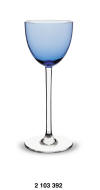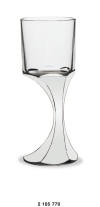|
|
the-south-asian.com January 2008 |
|
|||
|
Top
3 Indian Wineries Wine
culture
Health Films
- Book Reviews Heritage
People
|
|
||||
|
Turn a sip into a celebration! Special Feature by The South Asian Life & Times In this day and age of casual entertaining, we often ignore the joy and pleasure of using the right glass for the right wine. A good wine deserves a good glass. Nothing to prevent one from drinking wine out of a tumbler or even an espresso cup – but if the wine is special it deserves a glass that will enhance its personality. Baccarat, Christofle, Faberge, Miller Rogaska, Orrefors, Riedel, Rosenthal, Waterford have been the leaders in fine stemware. While Riedel have mastered the art of ‘form follows function’ and created wine glasses to match the grape, Baccarat have held their supremacy in luxury crystal stemware. Riedel – form follows function Riedel, the 250 year old Austrian manufacturers of fine stemware, have over 100 types and styles of glasses to choose from. Professor Claus J. Riedel was the first designer to recognize that the bouquet, taste, balance and finish of wines are affected by the shape of the glass from which they are drunk. Almost fifty years ago he began his pioneering work to create stemware that would match and complement different wines and spirits. In the late 1950s, Riedel started to produce glasses which at that time were a design revolution. Thin-blown, unadorned, reducing the design to its essence: Bowl, stem, base. Claus J. Riedel laid the groundwork for stemware which was functional as well as beautiful, and made according to the Bauhaus design principle: form follows function. In 1961 a revolutionary concept was introduced, when the Riedel catalogue featured the first line of wine glasses created in different sizes and shapes. Before this, conventional stemware had used a single basic bowl shape, with only the size varying depending on use. The concept was illustrated to perfection with the introduction of the Sommeliers series in 1973, which achieved worldwide recognition. A glass was born that was fine-tuned to match the grape! Riedel was able to create shapes in which the wine, vinified from specific grape varieties, seemed to improve. To fully appreciate the different grape varieties and the subtle characteristics of individual wines, it is essential to have a glass whose shape is fine-tuned for the purpose. The content determines the shape. Glasses may be used for similar varietals – a Bordeaux glass can be used for other full-bodied reds such as Cabernet Sauvignon and Merlot; a Burgundy glass for Pinot Noir. The size of a glass is important, affecting the quality and intensity of aromas. The breathing space has to be chosen according to the "personality” of the wine or spirit. Red wines require large glasses, white wines medium-sized glasses, and spirits small ones (to emphasize the fruit character and not the alcohol). Champagne is best served in a tall slender tulip glass. Visual enjoyment of the bubbles that differentiate a sparkling wine from a still wine is enhanced by the height of the glass. The glass should not be over filled. Red wine: four to five ounces; White wine: three ounces; Spirits: one ounce. And crystal does make the wine taste better! It really does.
Baccarat – still producing the world’s oldest and finest luxury crystal
For more than 200 years, Baccarat has produced and distributed some of the world's finest luxury crystal. Baccarat glasses have been held by Emperors, Kings, Queens, aristocracy, literary, artistic and even political celebrities the world over. The Harcourt design is the oldest and most famous of Baccarat stemware. Launched in 1841, it has been the most sought-after design that has adorned the dining tables of King Louis Philippe, Queen Victoria, Empress Eugenie, the Shah of Iran, Pope Benedict XV, and today - presidential palaces of many countries. A set of the service produced in 1841 continues to be used by the President of France during official receptions. Its hexagonal base, six-sided stem and triple knob, a gondola-shaped bowl with six flat sides that increasingly open up to the rim has given it a timeless appeal. Variations of the original design have since appeared in coloured crystal. (Baccarat pioneered the use of colour in crystal). As soon as it was launched in the market, both Coco Chanel and the American Ambassador to France chose Baccarat Perfection for their personal collection. Baccarat Narcisse, a much younger design than Harcourt and Perfection, has a contemporary look. Order your copy now. Annual subscription (inclusive of air shipping & handling) Rs 500 in India £25 elsewhere |
|||||
|
Copyright © 2000 - 2008 [the-south-asian.com]. Intellectual Property. All rights reserved. |
|||||


